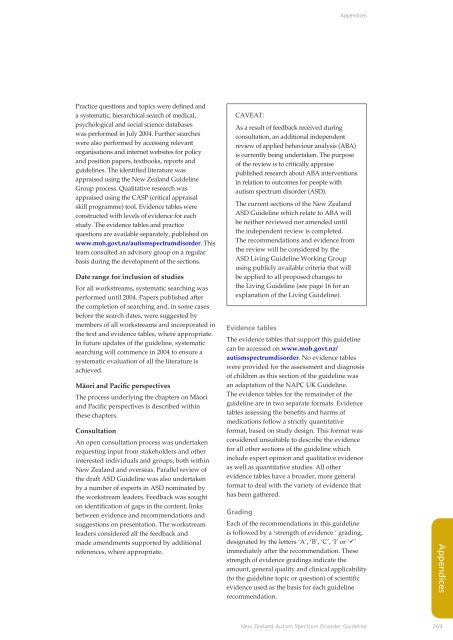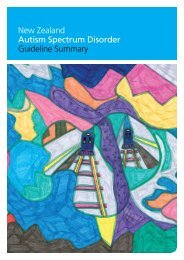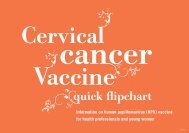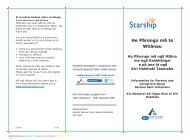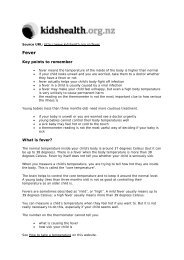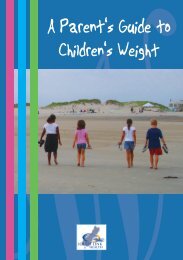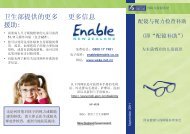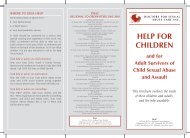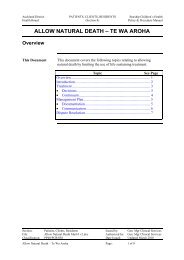New Zealand Autism Spectrum Disorder Guideline - Ministry of Health
New Zealand Autism Spectrum Disorder Guideline - Ministry of Health
New Zealand Autism Spectrum Disorder Guideline - Ministry of Health
You also want an ePaper? Increase the reach of your titles
YUMPU automatically turns print PDFs into web optimized ePapers that Google loves.
Appendices<br />
Practice questions and topics were defined and<br />
a systematic, hierarchical search <strong>of</strong> medical,<br />
psychological and social science databases<br />
was performed in July 2004. Further searches<br />
were also performed by accessing relevant<br />
organisations and internet websites for policy<br />
and position papers, textbooks, reports and<br />
guidelines. The identified literature was<br />
appraised using the <strong>New</strong> <strong>Zealand</strong> <strong>Guideline</strong><br />
Group process. Qualitative research was<br />
appraised using the CASP (critical appraisal<br />
skill programme) tool. Evidence tables were<br />
constructed with levels <strong>of</strong> evidence for each<br />
study. The evidence tables and practice<br />
questions are available separately, published on<br />
www.moh.govt.nz/autismspectrumdisorder. This<br />
team consulted an advisory group on a regular<br />
basis during the development <strong>of</strong> the sections.<br />
Date range for inclusion <strong>of</strong> studies<br />
For all workstreams, systematic searching was<br />
performed until 2004. Papers published after<br />
the completion <strong>of</strong> searching and, in some cases<br />
before the search dates, were suggested by<br />
members <strong>of</strong> all workstreams and incorporated in<br />
the text and evidence tables, where appropriate.<br />
In future updates <strong>of</strong> the guideline, systematic<br />
searching will commence in 2004 to ensure a<br />
systematic evaluation <strong>of</strong> all the literature is<br />
achieved.<br />
Mäori and Pacific perspectives<br />
The process underlying the chapters on Mäori<br />
and Pacific perspectives is described within<br />
these chapters.<br />
Consultation<br />
An open consultation process was undertaken<br />
requesting input from stakeholders and other<br />
interested individuals and groups, both within<br />
<strong>New</strong> <strong>Zealand</strong> and overseas. Parallel review <strong>of</strong><br />
the draft ASD <strong>Guideline</strong> was also undertaken<br />
by a number <strong>of</strong> experts in ASD nominated by<br />
the workstream leaders. Feedback was sought<br />
on identification <strong>of</strong> gaps in the content, links<br />
between evidence and recommendations and<br />
suggestions on presentation. The workstream<br />
leaders considered all the feedback and<br />
made amendments supported by additional<br />
references, where appropriate.<br />
CAVEAT:<br />
As a result <strong>of</strong> feedback received during<br />
consultation, an additional independent<br />
review <strong>of</strong> applied behaviour analysis (ABA)<br />
is currently being undertaken. The purpose<br />
<strong>of</strong> the review is to critically appraise<br />
published research about ABA interventions<br />
in relation to outcomes for people with<br />
autism spectrum disorder (ASD).<br />
The current sections <strong>of</strong> the <strong>New</strong> <strong>Zealand</strong><br />
ASD <strong>Guideline</strong> which relate to ABA will<br />
be neither reviewed nor amended until<br />
the independent review is completed.<br />
The recommendations and evidence from<br />
the review will be considered by the<br />
ASD Living <strong>Guideline</strong> Working Group<br />
using publicly available criteria that will<br />
be applied to all proposed changes to<br />
the Living <strong>Guideline</strong> (see page 16 for an<br />
explanation <strong>of</strong> the Living <strong>Guideline</strong>).<br />
Evidence tables<br />
The evidence tables that support this guideline<br />
can be accessed on www.moh.govt.nz/<br />
autismspectrumdisorder. No evidence tables<br />
were provided for the assessment and diagnosis<br />
<strong>of</strong> children as this section <strong>of</strong> the guideline was<br />
an adaptation <strong>of</strong> the NAPC UK <strong>Guideline</strong>.<br />
The evidence tables for the remainder <strong>of</strong> the<br />
guideline are in two separate formats. Evidence<br />
tables assessing the benefits and harms <strong>of</strong><br />
medications follow a strictly quantitative<br />
format, based on study design. This format was<br />
considered unsuitable to describe the evidence<br />
for all other sections <strong>of</strong> the guideline which<br />
include expert opinion and qualitative evidence<br />
as well as quantitative studies. All other<br />
evidence tables have a broader, more general<br />
format to deal with the variety <strong>of</strong> evidence that<br />
has been gathered.<br />
Grading<br />
Each <strong>of</strong> the recommendations in this guideline<br />
is followed by a ‘strength <strong>of</strong> evidence ‘ grading,<br />
designated by the letters ‘A’, ‘B’, ‘C’, ‘I’ or ‘’<br />
immediately after the recommendation. These<br />
strength <strong>of</strong> evidence gradings indicate the<br />
amount, general quality and clinical applicability<br />
(to the guideline topic or question) <strong>of</strong> scientific<br />
evidence used as the basis for each guideline<br />
recommendation.<br />
Appendices<br />
<strong>New</strong> <strong>Zealand</strong> <strong>Autism</strong> <strong>Spectrum</strong> <strong>Disorder</strong> <strong>Guideline</strong> 269


